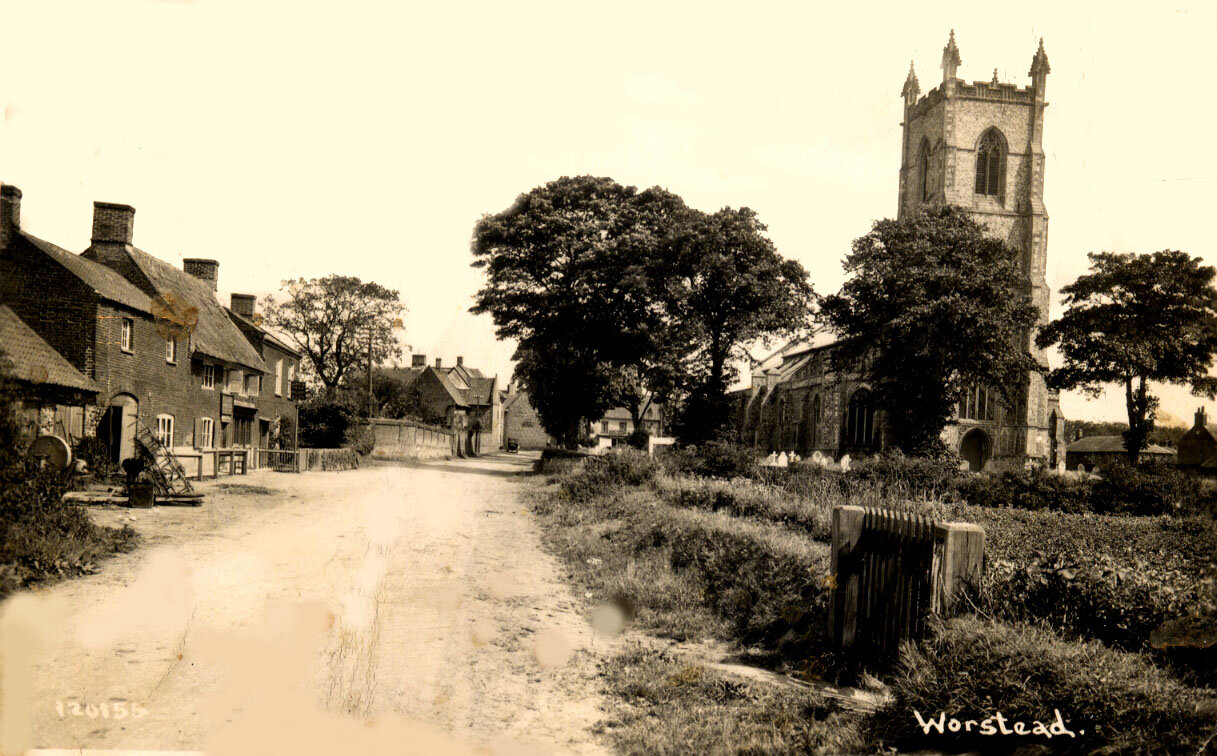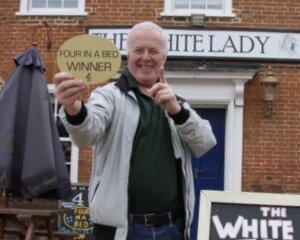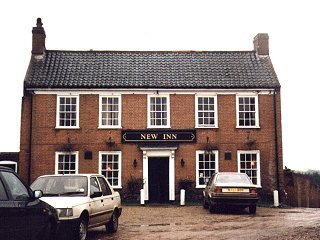
St Marys Church, Worstead
‘WORSTED’
a woollen fabric made from well-twisted yarn spun from long-staple wool combed to lay fibres parallel ,giving both warmth and strength.
William Paston, 1378-1444, wrote to his cousin Robert
"I pray that you will send me hither two ells (ell = 45") of Worsted for doublets, to happen (wrap me up warm) this cold winter, and that ye enquire where William Paston bought his tippet of fine worsted cloth, which is almost like silk, and if that be much finer than that ye should by me, after seven or eight shillings, then buy me a quarter and a nail (13¼") thereof for collars, though it be dearer than the others, for I shall make my doublet all Worsted, for the glory of Norfolk."
EDP ARTICLE 15TH JULY 2011
'A STRUGGLING PUB IN A PICTURESQUE NORTH NORFOLK VILLAGE HAS BEEN BOUGHT BY A RESIDENT AND RENAMED AFTER A LOCAL GHOST'.
Worstead’s New Inn will now be known as The White Lady, celebrating a chilling legend about a ghost said to haunt the neighbouring church on Christmas Eve.The White Lady with Diane. St Mary's Church, Worstead. August 1975The name change is part of a major refurbishment of the 19th-century Grade II-listed building, Worstead’s only pub, by its new owner, Dennis Gilligan, who has bought it from Punch Taverns.He has employed village craftsmen to revamp the kitchen and carry out other work, and has taken on five full-time staff from the village, including chef Mark Thompson who is cooking dishes using local suppliers. The pub will also sell Norfolk beer such as Woodforde’s.Mr Gilligan, who had never pulled a pint before his latest purchase, said he had been sad to see the pub’s decline and eventual closure several months ago and wanted to see it become a community hub once again.He decided on the name change because he felt New Inn sounded “very 1960s” and found inspiration in his own home, which had once been another Worstead pub, the King’s Head.An old newspaper cutting left there told of the White Lady legend and said that a man staying in the King’s Head with friends one Christmas Eve had decided to test the legend of the ghost’s appearance and went to the church. His friends later found him “gibbering with fright,” repeatedly saying: “I have seen her,” before dropping dead.The pub has been open throughout the refurbishment but Mr Gilligan, 59, a trainer and assessor for the National Grid, plans an official re-launch on Friday, July 22, with live music from village band 'The Usual Suspects' when it is hoped that a new pub sign, designed by Worstead artist Laura Rose, will have been installed. Extra supplies have also been ordered for the Worstead Festival at the end of July, and a pub beer and music festival is planned over the August bank holiday.Longer-term plans include creating a conservatory restaurant and a micro-brewery in an outbuilding.Simon Cole, chairman of Worstead Parish Council, said: “The pub’s an important part of the village and I think everyone is upbeat about what’s happening there. We’re looking forward to a rosy future.”Since opening, the pub has grown to include now five beautiful self catering cottages and is now an officially recognised as a community asset.
In 2014 The White Lady won Channel 4’s ‘Four in a Bed’
Welcome to the The White Lady, Worstead.
Worstead is in North East Norfolk, once a popular town but now a small village served by the Church of St. Mary's. It is recorded in the doomsday book as once having two churches which served an area of twenty six acres of land.
The village consists of a main street and a square, where markets and hiring fairs were once held. There used to be a great number of shops and businesses, if you look carefully in the village you can see where the old shops once stood.
According to the date panel on the side of the pub - ‘The New Inn’ as it was then called was built in 1825 by Sir G.B Brograve after the original pub at the end of the church was knocked down, apparently due to the noise the patrons were making causing problems for the church !!
The original ‘New Inn’
Our History
Wrdesteda or Ordested, as Domesday calls the village, was given by King Canute to the abbots of St. Benet of Holme, amid the Norfolk Broads. These abbots held the manor till the dissolution of the monasteries in 1538. During the time of Edward the Confessor the manor was held for the abbots by Robert, an officer of the cross-bow men. His son Odo took over the holding on his father's death and assumed the name of 'De Worstead'.
Worstead gives its name to a type of cloth 'Worsted' which was woven in the village in the middle ages. From the conquest onwards Flemish weavers migrated to England, but it was not until the reign of Edward II that their cloth came to be known as ‘Worsted’. Hitherto most of the Norfolk wool had been exported to Flanders whence it was imported in the form of cloth.
Early in his reign Edward III, married to a Flemish princess, actively encouraged immigration of Flemings to "exercise their mysteries in the kingdom". Attracted by abundant supplies of wool in England, a considerable number of weavers settled in and around Norwich where the landscape resembled their native country and where Norfolk sheep produced the same long staple as they had used in Flanders. This was made into the cloth called Worsted (defined as a woollen fabric made from well-twisted yarn spun from long-staple wool combed to lay fibres parallel) giving both warmth and strength.
Thus was founded the name of a skilful trade which brought not only wealth and prosperity to England for 600 years but also provided a household word throughout the world.
The weavers brought in a good wage each week; by 1830 the weekly wage was 20-25 shillings. Weaving flourished in the village for over five hundred years, till the last weaver, John Cubitt, died in 1882 aged 91 years. The hand-loom weavers were forced out of business by the power-driven machines of the West Riding of Yorkshire where both water and coal were readily available. And there it remains to this day, centred on Bradford and Huddersfield.
Various reminders of the weaving industry can be seen in the village, especially in our church. On its floor are several brasses telling the same story engraved in Latin, such as "Tom Watt, worsted weaver, died 16th August 1506".
Some of the weavers houses in and around the village survive. They are large and spacious, it was in these that weaving looms, 12ft high were used. Each house had its own cellar with wooden beams interlacing the ceiling, wherein the wool was stored at a cool even temperature. The crypt of one house with a groined ceiling still survives at the bottom of a derelict stair under the bake house in the market square.
'THE WHITE LADY'
The above photograph, taken in August 1975, is one of the most convincing images ever captured of supernatural phenomena. And many believe the spooky snap is proof of the existence of the famous White Lady of Worstead.
The picture was taken by Peter Berthelot while he and his family were visiting the church of St Mary’s in the sleepy Norfolk village.
At the time the shutter clicked there was no one behind his wife Diane.
It was only after he had the film developed and then put on a slideshow at the couple’s home in Chelmsford, Essex, that they noticed the ghoulish figure,.
It looked as if she was wearing a bonnet and old fashioned clothes. Diane recalls: “When we saw the white figure sitting behind me on the projector screen we just stood there with our mouths open.”
When they returned the following year to show the vicar the slide, he told them about the legend of the White Lady, which dates back centuries one man, staying in the village on Christmas Eve 1830, climbed into the church belfry to investigate the stories about her.
He was later found “gibbering with fright” saying “I have seen her, I have seen her”, before dropping dead.
But Diane believes the ghost is a healing influence. She says that when she originally sat in the church she had a strange tingling sensation and credits the spirit with keeping her healthy ever since.
The original photograph can be seen on the wall inside the bar of the pub... what do you think?
Since opening, the pub has grown to include now five beautiful self catering cottages and is now an officially recognised as a community asset.





